Text
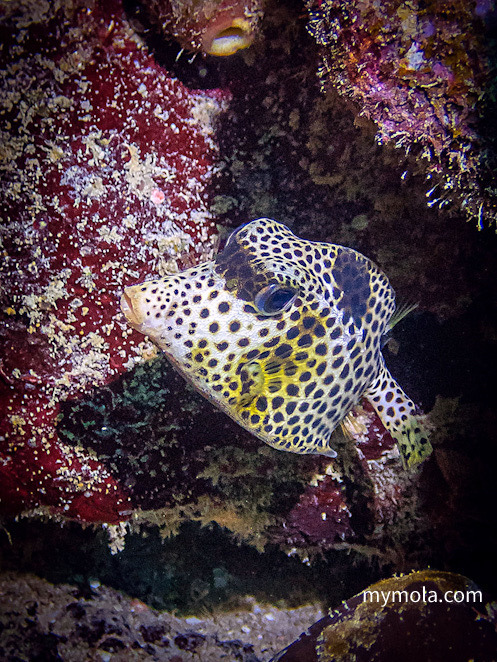
Spotted trunkfish (Lactophrys bicaudalis) are one of only three recognized members of the Lactophrys genesis. The others are the buffalo trunkfish (Lactophrys trigonus) and the smooth trunkfish (Lactophrys triqueter). All are native to the western Atlantic Ocean and are referred to as cowfish, or simply boxfish, depending on where they are encountered. The spotted trunkfish is yellow, white or a combination of both with dark spots. Its snout and fins protrude from a triangular, trunk-like body, armored with heavy hexagonal scales. This armor and the colorless toxin secreted from its glands greatly deter predators. In fact, the toxin is so powerful, it can kill a large shark if ingested. Due to the weight of its scales, this fish is most often observed moving in a slow hovering motion powered by the non-stop fluttering of its pectoral fins. However, it will use its tail fin to propel itself quite quickly if it feels threatened. We photographed this spotted trunkfish while writing our post Scuba Diving Placencia, Belize.
7 notes
·
View notes
Text
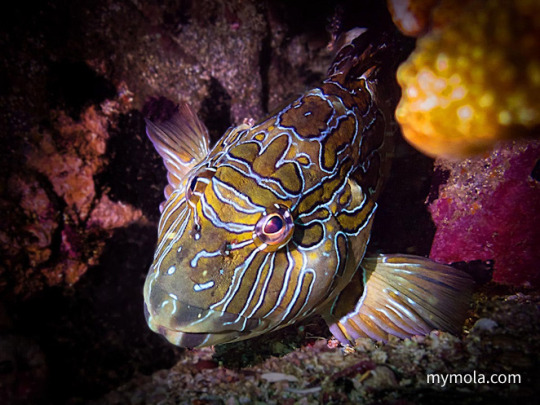
Giant hawkfish (Cirrhitus rivulatus) As its name suggests, the giant hawkfish is the largest member of the hawkfish family, growing up to 60 cm/24 inches in length. They are seen regularly by divers around the Gulf of California where they are called “China Marino,” but have been identified as far south as the Galapagos Islands. These fish are typically unfazed by diver activity and are known for their ability to prop themselves on their pectoral fins and even brace themselves against crashing waves in shallow rocky waters. They feed mainly on small fish and crustaceans and are currently categorized as “Least Concern” on the IUCN Red List. Read more in our post, Scuba Diving Huatulco, Mexico. https://www.mymola.com/scuba-diving-huatulco-mexico/
#travel #funfacts #scuba #scubadiving #diving #underwaterphotography #uw #underwater #scubadive #dive #uwphoto #scubaphoto #diver #scubadivers #marinebiology #underwaterpics #wildlifephotography #wildlife #photooftheday #marinelife #nature #mexico #animalfacts #stingray #photography #macrophotography #macrophotographylove #naturephotography #naturephotographer
1 note
·
View note
Text
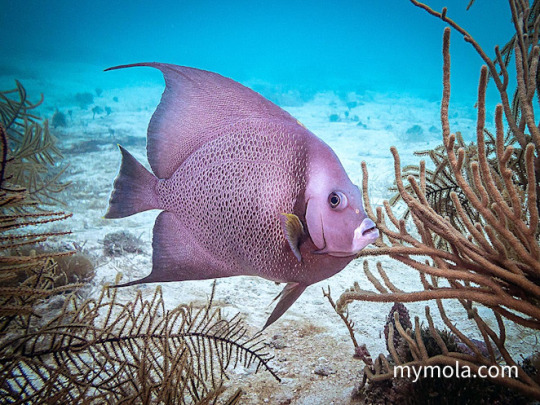
Gray angelfish (Pomacanthus arcuatus) - These fish are commonly found along the western Atlantic, particularly in warmer waters around the Bahamas, Gulf of Mexico and the Caribbean. Adults measure up to 60cm (23 inches) and can weigh as much as 2kg (4.5 lbs), making them the largest known species of marine angelfish. Though they feed mainly on sponges, their diet includes tunicates, algae, gorgonians, and seagrass. Juveniles also fatten up by cleaning parasites off other species. These fish are sometimes curious about divers, and may even follow along on a dive. Read more in our post, Scuba Diving Placencia, Belize. https://www.mymola.com/scuba-diving-placencia-belize/
#scuba #scubadiving #divetravel #uwphotography #belize
0 notes
Text
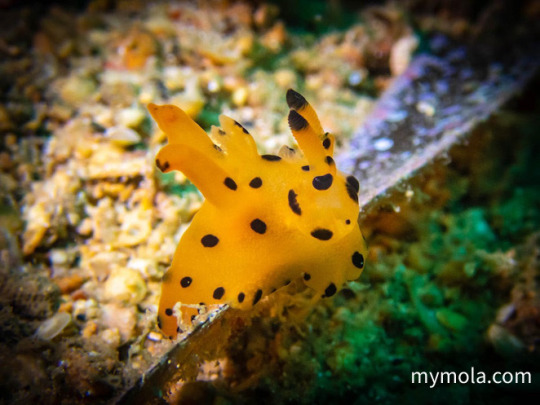
Pikachu nudibranch (Thecacera sp) - This colorful marine mollusk is part of the Thecacera genus of sea slugs. It is nicknamed for its resemblance to the adorable character, Pikachu, from the Pokémon franchise. At just 2cm, this Pikachu nudibranch is not easy to spot. Sightings are rare but are known to occur around Indonesia, Borneo, Western Australia and Japan. We photographed this Pikachu nudibranch while diving off the coast of Sekotong in Lombok, Indonesia. Read more in our post, A Scuba Diver’s Guide to Lombok, Indonesia.
https://www.mymola.com/a-scuba-divers-guide-to-lombok-indonesia/
#travel #funfacts #scuba #scubadiving #diving #underwaterphotography #uw #underwater #scubadive #dive #uwphoto #scubaphoto #diver #scubadivers #marinebiology #underwaterpics #wildlifephotography #wildlife #photooftheday #marinelife #nature #animalfacts #stingray #photography #macrophotography #macrophotographylove #naturephotography #naturephotographer #lombok
0 notes
Text
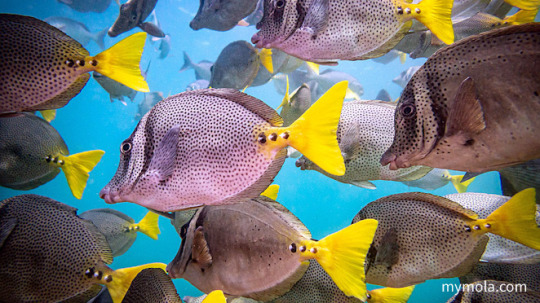
Yellowtail Surgeonfish (Prionurus punctatus)
These lovely spotted fish are easily identified by their bright yellow tails and the dark vertical stripes across their eyes and gills. The three sharp protruding spines on either side of their tails are easily seen and serve as their main defense against predators. They are very common from the Gulf of California to El Salvador. We photographed these Yellowtail Surgeonfish during a dive in Huatulco, Mexico. Read more in our article Scuba Diving, Huatulco, Mexico. https://www.mymola.com/scuba-diving-huatulco-mexico/
#travel #scuba #scubadiving #diving #underwaterphotography #uw #underwater #scubadive #dive #uwphoto #scubaphoto #diver #scubadivers #marinebiology #underwaterpics #wildlifephotography #wildlife #photooftheday #marinelife #nature #mexico #animalfacts #stingray #photography #macrophotography #macrophotographylove #naturephotography #naturephotographer
0 notes
Text

Flamingo Tongue Snail (Cyphoma gibbosum)
The orange-yellow color and dark spots that make these snails easy to see comes from their retractable mantles when wrapped around their shells. These small sea snails make their home in the western Atlantic Ocean preying on soft corals like sea fans and whip corals. They live nearly their entire existence attached to these corals and are able to ingest the coral's chemical defenses and absorb them into their bodies for their own protection. Females attach their eggs to their coral prey and the larvae hatch in just 10 days. After a short planktonic stage, they attach themselves to a soft coral of their own to live out their days. Corals are able to regrow polyps the flaming tongue scrapes away with its radula and thrive on, keeping both themselves and the flamingo tongue alive. Though this species was once very common, it is currently in decline in areas heavily trafficked by snorkelers and divers. We photographed this flamingo tongue while freediving between Lighthouse and Moon Hole in Utila, Honduras. #travel #funfacts #scuba #scubadiving #diving #uw #underwater #scubadive #dive #uwphoto #scubaphoto #diver #scubadivers #marinebiology #underwaterpics #wildlifephotography #wildlife #photooftheday #ocean #marinelife #nature #utila #animalfacts #stingray #photography #macrophotography #macrophotographylove #naturephotography #naturephotographer #supportutila
1 note
·
View note
Text
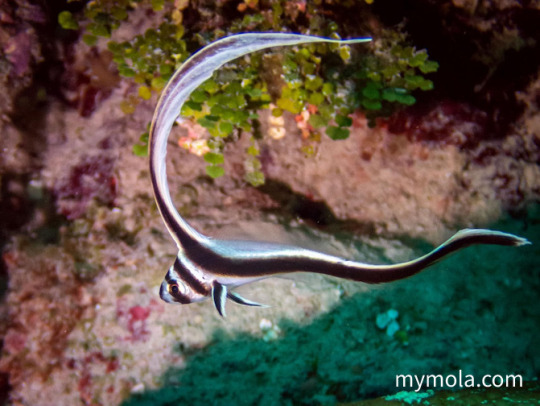
Juvenile Spotted Drum Fish (Equetus punctatus ) - There are around 275 species of drum fish living in oceans and freshwater. One of the loveliest drums to encounter is the juvenile spotted drum. Spotted drums are most striking as juveniles when their long flowing fins accentuate a black and white striped pattern that becomes quite hypnotic as they swim in repetitive circular patterns beneath coral overhangs, and in other sheltered crevices. As they mature, and their bodies grow, their dorsal fins become shorter and the stripes along their back half morph into spots. Drum fish are named for a deep sound they produce by beating their abdominal muscles against their swim bladder. The purpose of the sound varies from species to species, but for many it is used for mating, or as a danger warning. These fish are found in the Gulf of Mexico, the Caribbean Sea and in the Atlantic Ocean from Florida to Brazil. We photographed this Spotted Drum during a dive in Utila, Bay Islands, Honduras.
4 notes
·
View notes
Text
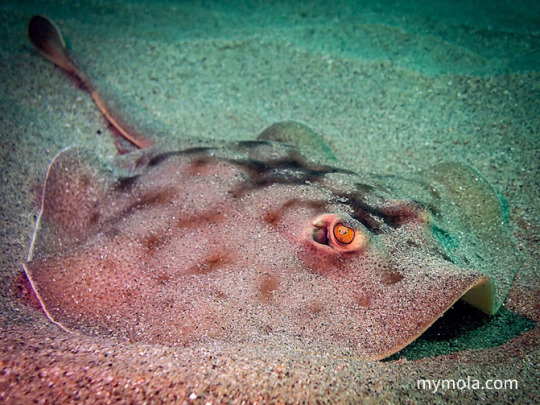
The Bullseye Round Stingray (Urobatis concentricus) is named for the circular shape of its flat spotted body and belongs to the round family of stingrays. This ray grows to a length of 19 inches and a width of 11 inches. Its tail is much shorter than most stingrays, but it does have a venomous spine near the middle of it. Like all stingrays, the bullseye round is non-aggressive toward humans and only raises its tail in defense when it feels threatened.
There are some who believe this stingray is not a full species, but simply a color morph of the round stingray (Urobatis helleri). However, the taxonomy of the bullseye round is still being investigated, so there is not currently no confirmation either way. It is endemic to Mexico but is currently listed as Date Deficient on the IUCN Red List.
We photographed this Bullseye Round Stingray during a dive in Hualtulco, Mexico. Read more in our post on Scuba Diving Hualtulco.
3 notes
·
View notes
Text
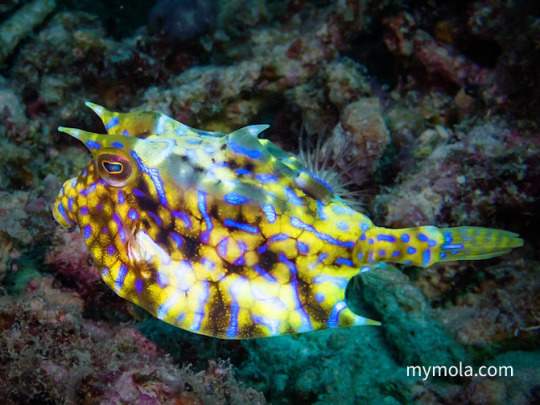
It is found in the tropical Indo-Pacific, Japan, and Hawaii where it feeds on invertebrates it hunts by blowing streams of water along the sand to expose its prey. This fish grows to between 6 to 9 inches long and can camouflage itself by changing color to blend with its environment. Like many cowfish, it is typically solitary, and males are territorial during mating season. We photographed this thornback cowfish during a dive in Gili Air Indonesia. Read more in our post, A Scuba Divers Guide to Lombok, Indonesia.
5 notes
·
View notes
Photo
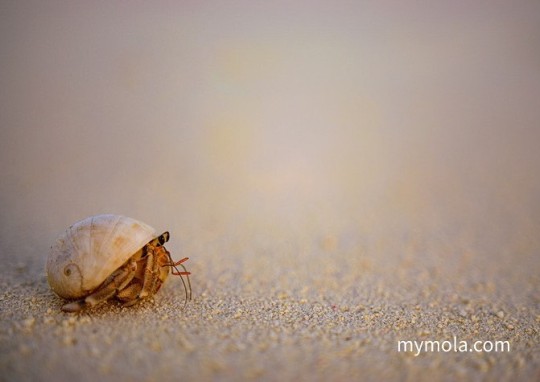
Most hermit Crabs live their lives inside seashells and other salvaged objects that serve as armor to protect their soft spiral shaped abdomens from predators. There are two types of hermit crabs, marine and terrestrial. All marine hermit crabs live in the ocean, except for a single species, Clibanarius fonticola, that lives in fresh water. Terrestrial crabs prefer land in tropical areas near water. Both breath through gills, and must keep them damp or wet in order to avoid suffocating. All hermit crabs are scavengers, feeding on plants, fallen fruit, turtle eggs, dead fish, plankton and just about anything edible they come across. These social creatures live and forage in groups. Most are nocturnal, preferring the safety of darkness on land and in the water. As they grow, hermit crabs must find new homes to accommodate their larger size. Whether aquatic or terrestrial, these crabs will fight one another for the best shell, and have even been known to steal shells from one another when they can get away with it. We photographed this hermit crab on Angaga Island in The Maldives. Read more about Scuba Diving in Ari Atoll, Maldives here https://www.mymola.com/scuba-diving-in-ari-atoll-maldives/
#travel#funfacts#scuba#scubadiving#diving#underwaterphotography#uw#underwater#scubadive#dive#uwphoto#scubaphoto#diver#scubadivers#marinebiology#underwaterpics#wildlifephotography#wildlife#photooftheday#marinelife#nature#maldives#animalfacts#photography#crab#macrophotography#macrophotographylove#naturephotography#naturephotographer
5 notes
·
View notes
Photo
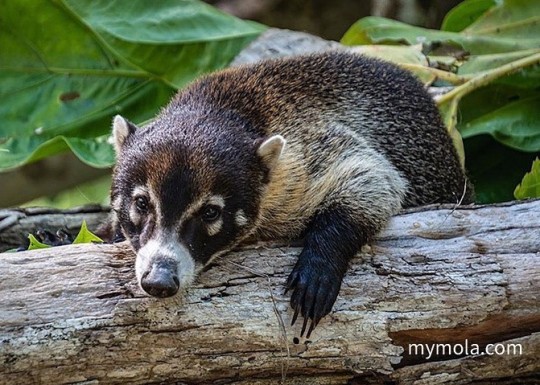
White-nosed coatis (Nasua narica), or “pizotes” in Spanish, are related to the racoon and found throughout the Americas. They are social animals who live in troops of three to 20 animals. These troops include females and their young only. Males will leave their troop at around two years of age when they reach adulthood and remain solitary unless mating. These are polygynous animals, so during a short mating period from February through March, troops will permit a single male to live among them and mate with the sexually mature females. After mating has come to an end the adult male is chased from the troop because they often become aggressive toward juveniles and may even kill them. White-nosed coatis are omnivores and have been known to travel as far as 2,000 miles in search of food. Their preferred meals consist of fruit, insects, carrion, and small reptiles or rodents. They are exceptional tree climbers, using their long tails to balance themselves. However, most of their foraging is done on the ground, where they poke their flexible snouts into crevices in search of prey. They share a dependant relationship with balsa trees, seeking sustenance from balsa tree flowers, particularly when food is sparse. The coati’s faces become covered in pollen when they dip their long snouts in to drink the nectar. When the coatis move through the forest, they spread the pollen from one flower to the next. We photographed this White-nosed coati during a visit to Tikal in Guatemala. #travel #funfacts #nature #animals #naturephotography #wildlifephotography #wildlife #photooftheday #animalphotography #naturephotography #animalfacts (at Tikal, Peten, Guatemala) https://www.instagram.com/p/B9R0tuMhfUj/?igshid=1a6q95pz8dfoq
#travel#funfacts#nature#animals#naturephotography#wildlifephotography#wildlife#photooftheday#animalphotography#animalfacts
3 notes
·
View notes
Photo
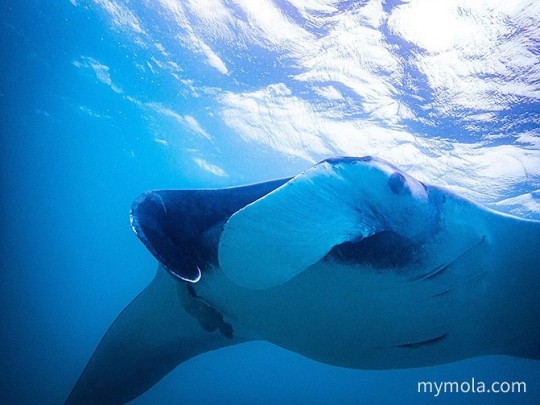
The Manta ray is the largest of more than 500 species of rays. The name manta means blanket in Spanish and was given to them due to their large flat diamond shaped bodies that resemble the spreading of a blanket as they gracefully glide through the water. There are two recognized species of manta rays; Giant oceanic mantas (Mobula birostris) and Reef mantas (Mobula alfredi). Both live up to 50 years and are known for being highly intelligent. Their ability to memorize and map terrain through sight and smell is an indication of highly developed long-term memory. Manta rays also recognize their own reflection and are believed to be self-aware. Reef mantas, the smaller of the two species, are sighted far more often than Giant mantas because they stay near shore and tend to be curious. They usually grow to around 3.5 meters but can get up to 5.5 meters. Giant oceanic manta rays have a wingspan of up to 9 meters and weigh as much as 3000 lbs. Wary of human interaction, they live offshore in open water and are believed to migrate much farther than reef mantas. For positive manta interactions hover away from cleaning stations and wait for them to investigate you. These curious beauties will swim quite close to check you out if you’re patient and non-aggressive. If you chase them their powerful pectoral fins will carry them away in a flash. Like fingerprints, patterns on the bellies of mantas are unique. Researchers use the patterns to identify and track mantas. You can help them by photographing the underside of mantas and submitting photos online at MantaMatcher.org All mantas are currently listed as “vulnerable to extinction” on the IUCN Red List of Threatened Species. There numbers have decreased significantly over the past 20 years due to overfishing and the use of their gill rakers in traditional Chinese medicine. We photographed this manta ray during a dive at Laughing Bird Caye with @splashdive #travel #funfacts #scuba #scubadiving #diving #underwaterphotography #uw #mantarays #underwater #scubadive #dive #uwphoto #scubaphoto #diver #scubadivers #marinebiology #underwaterpics #wildlifephotography #wildlife #photooftheday #marinelife #nature #animalfacts https://www.instagram.com/p/B9FGSiFhU63/?igshid=ks0gqonwbwt0
#travel#funfacts#scuba#scubadiving#diving#underwaterphotography#uw#mantarays#underwater#scubadive#dive#uwphoto#scubaphoto#diver#scubadivers#marinebiology#underwaterpics#wildlifephotography#wildlife#photooftheday#marinelife#nature#animalfacts
5 notes
·
View notes
Photo
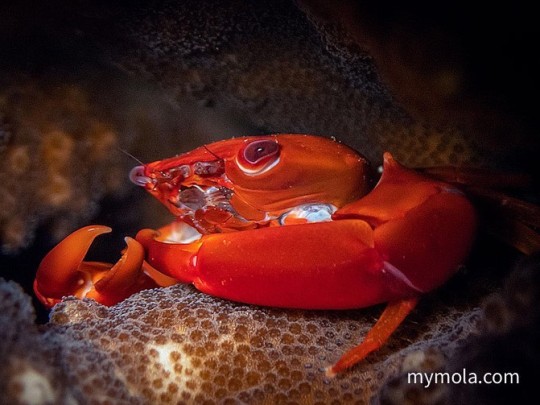
Rusty Guard Crabs (Trapezia bidentata) grow to be no more than two inches wide. These tiny crustaceans live out their lives along the branches of small polyp corals like Pocilloporas and Acroporas; with whom they share a mutualistic relationship. As their name suggests, the guard crab protects the coral from predators, often by waving their fat, stubby claws at any perceived threat. In return, the crabs feed on the coral’s polyps and mucus, typically massaging the polyps until the mucus is released and collected in their leg hairs before being passed to their mouths. We photographed this Rusty Guard Crab during a dive in Huatulco, Mexico with Scuba Diving Anfibios Huatulco. #travel #funfacts #scuba #scubadiving #diving #underwaterphotography #uw #underwater #scubadive #dive #uwphoto #scubaphoto #diver #scubadivers #marinebiology #underwaterpics #wildlifephotography #wildlife #photooftheday #marinelife #nature #mexico #animalfacts #morayeel #photography #crab #macrophotography #macrophotographylove #naturephotography #naturephotographer (at Huatulco, Mexico)
https://www.instagram.com/p/B89kunrBsaK/?igshid=5px2dfjxyjlc
#travel#funfacts#scuba#scubadiving#diving#underwaterphotography#uw#underwater#scubadive#dive#uwphoto#scubaphoto#diver#scubadivers#marinebiology#underwaterpics#wildlifephotography#wildlife#photooftheday#marinelife#nature#mexico#animalfacts#morayeel#photography#crab#macrophotography#macrophotographylove#naturephotography#naturephotographer
2 notes
·
View notes
Photo
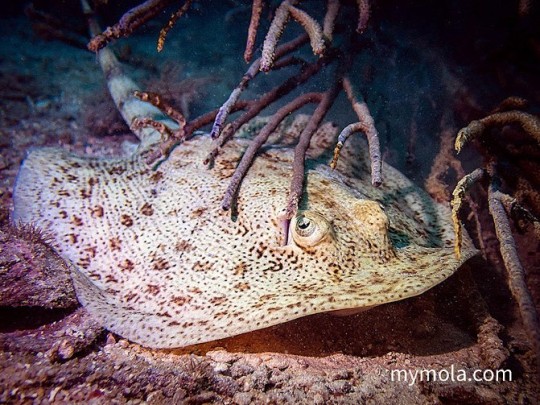
The Yellow Stingray (Urobatis jamaicensis) is a small stingray with a wingspan of up to only 14 inches. It is commonly found in the Atlantic Ocean from Trinidad to North Carolina and is non-threatening to human beings. However, these rays can inflict extremely painful injuries when threatened, and most that have been reported occurred when people accidentally stepped on the rays who slash and raise their tail spines when attempting to flee. Still, lethal injuries are very rare. The yellow stingray is aplacental viviparity, meaning their embryos develop inside eggs that remain in the body of the mother until they ready to hatch. During their 5-6-month gestation period, the embryos are sustained first by yolk, then by uterine milk called histrotroph during the later part of their development. Females give birth no more than twice per year, with litters of one to seven pups. This ray is not one of the 45 species of stingrays listed as threatened or endangered on the International Union for Conservation of Nature (IUCN). Their numbers are currently at healthy levels, so they are listed as “Least concern.” We photographed this yellow stingray during a dive with @splashdivecenter at Laughing Bird Caye in Belize. #travel #funfacts #scuba #scubadiving #diving #underwaterphotography #uw #underwater #scubadive #dive #uwphoto #scubaphoto #diver #scubadivers #marinebiology #underwaterpics #wildlifephotography #wildlife #photooftheday #marinelife #nature #animalfacts #photography #sealife #naturephotography #naturephotographer #oceanphotography (at Laughing Bird Caye) https://www.instagram.com/p/B87AGXJhHrT/?igshid=gxgwwwi3sl86
#travel#funfacts#scuba#scubadiving#diving#underwaterphotography#uw#underwater#scubadive#dive#uwphoto#scubaphoto#diver#scubadivers#marinebiology#underwaterpics#wildlifephotography#wildlife#photooftheday#marinelife#nature#animalfacts#photography#sealife#naturephotography#naturephotographer#oceanphotography
0 notes
Photo
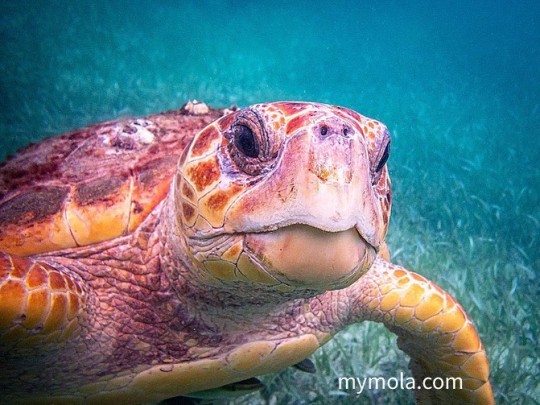
The Loggerhead Sea Turtle (Caretta caretta) can be found in the Indian, Mediterranean, Atlantic, and Pacific Oceans. Adults can weigh up to 1,000 lbs, but the average full grown adult weighs in at around 300 lbs. Their considerable size detours many predators. However, large marine animals, such as sharks, do feed on loggerheads. These turtles live up to 50-70 years, and reach sexual maturity between 17-33 years old. However, they have a very low reproductive rate; females lay just four egg clutches before becoming dormant for two to three years. A total of nine distinct population segments of loggerheads are protected under the 1973 Endangered Species Act, but they are currently listed as Near Threatened on the IUCN Red List. Loggerheads are often caught as bycatch in trawling nets. This along with coastal development of housing and tourism for humans are the leading threats to their existence. We photographed this loggerhead during a day of diving with @splashdivecenter and @lena.on.the.move at Silk Cayes Marine Reserve. #travel #funfacts #scuba #scubadiving #diving #underwaterphotography #uw #underwater #scubadive #dive #uwphoto #scubaphoto #diver #scubadivers #marinebiology #underwaterpics #wildlifephotography #wildlife #photooftheday #marinelife #nature #animalfacts #photography #macrophotography #macrophotographylove #sealife #naturephotography #naturephotographer #turtle https://www.instagram.com/p/B7Rxg4vBsVe/?igshid=2rz4xd25on97
#travel#funfacts#scuba#scubadiving#diving#underwaterphotography#uw#underwater#scubadive#dive#uwphoto#scubaphoto#diver#scubadivers#marinebiology#underwaterpics#wildlifephotography#wildlife#photooftheday#marinelife#nature#animalfacts#photography#macrophotography#macrophotographylove#sealife#naturephotography#naturephotographer#turtle
0 notes
Photo
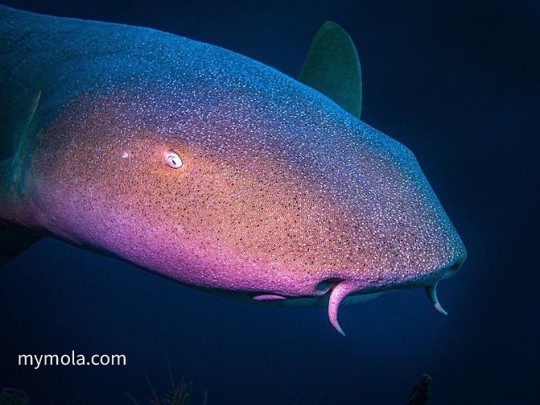
The Nurse Shark( Ginglymostoma cirratum) Unlike many shark species, nurse sharks are able to move water through their gills independently without swimming, which enables them to rest along the ocean floor.
This sedentary bottom dweller behavior and their sometimes social nature with humans can lead people to believe these sharks are harmless. However, though nearly all bites by nurse sharks are a result of misguided human behavior toward the sharks, they are currently one of the most likely species of shark to bite human beings.
Nurse sharks are suction feeders. Their diet consists mainly of invertebrates, small fish and stingrays, and though their mouths are quite small, they have the strongest suction ability recorded in an aquatic animal. They feed individually at night but have also been know to hunt in packs during the day.
The endangered status of nurse sharks on the IUCN list varies by species and location, it ranges from decreasing to unknown due to lack of data. In the country of Belize, nurse sharks are protected by law. To harm or kill a nurse shark is considered a serious offense by law enforcement and the Belizean people.
We photographed this nurse shark during a dive with @splashdivecenter and near Silk Cayes Marine Reserve.
#travel #funfacts #scuba #scubadiving #diving #underwaterphotography #uw #underwater #scubadive #dive #uwphoto #scubaphoto #diver #scubadivers #marinebiology #underwaterpics #wildlifephotography #wildlife #photooftheday #marinelife #nature #animalfacts #photography #macrophotography #macrophotographylove #sealife #naturephotography #naturephotographer #nursesharks (at Placencia, Belize) https://www.instagram.com/p/B7JLOYGhi6p/?igshid=1h2jgvaqu6l61
#travel#funfacts#scuba#scubadiving#diving#underwaterphotography#uw#underwater#scubadive#dive#uwphoto#scubaphoto#diver#scubadivers#marinebiology#underwaterpics#wildlifephotography#wildlife#photooftheday#marinelife#nature#animalfacts#photography#macrophotography#macrophotographylove#sealife#naturephotography#naturephotographer#nursesharks
3 notes
·
View notes
Photo

Pacific Arrow Crab (Stenorhynchus debilis) can grow to up to 4-6 inches in width, and is characterized by its triangular shell and 10 long spindly legs. This crab is a nocturnal hunter who feeds on algae, gastropods and small crustaceans. However, the Arrow crab is not a picky eater, and will feed on just about anything dead or slow. The Pacific Arrow Crab makes its home in reef crevices and rocky intertidal areas. It is found throughout the Mexican Pacific, and, during El Niño years, has been spotted as far as north as the southern California shores of the United States. We photographed this Pacific Arrow Crab during a dive in Hualtuco, Mexico with Scuba Diving Anfibios Hualtulco. #travel #funfacts #scuba #scubadiving #diving #underwaterphotography #uw #underwater #scubadive #dive #uwphoto #scubaphoto #diver #scubadivers #marinebiology #underwaterpics #wildlifephotography #wildlife #photooftheday #marinelife #nature #mexico #animalfacts #morayeel #photography #macrophotography #macrophotographylove #sealife #naturephotography #naturephotographer (at Huatulco Oaxaca)
https://www.instagram.com/p/B68sTiUBzHw/?igshid=1j6rek8gd4hau
#travel#funfacts#scuba#scubadiving#diving#underwaterphotography#uw#underwater#scubadive#dive#uwphoto#scubaphoto#diver#scubadivers#marinebiology#underwaterpics#wildlifephotography#wildlife#photooftheday#marinelife#nature#mexico#animalfacts#morayeel#photography#macrophotography#macrophotographylove#sealife#naturephotography#naturephotographer
2 notes
·
View notes